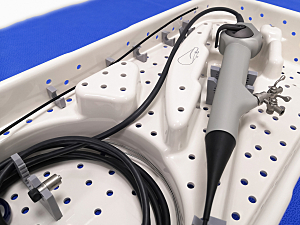Flexible ureteroscopy (URS) is the most commonly used surgical procedure to treat nephrolithiasis, but there is no standardized methodology for URS skills assessment.
To address this gap, Marie-Therese Valovska, MD, a fourth-year urology resident in the Division of Urology at Brigham and Women’s Hospital, Daniel A. Wollin, MD, MS, a urologic surgeon in the Division and an assistant professor of surgery at Harvard Medical School, and colleagues have begun to evaluate how surgeon movements affect URS efficiency. In the Journal of Endourology, they report results from a pilot study that should inform improvement in endoscopist training and evaluation.
Methods
The team recruited 12 urologists to use a flexible ureteroscope to target stones within a simulation box that none had encountered previously, while being prevented from seeing inside. The average age of the participants was 37 (range, 28–62), and the average time in practice was 10 years (range, 1–35 years). Half were women, half were trainees, and one-third were endourology fellowship-trained.
Before participating in the simulation, each surgeon was fitted with 41 reflective markers so a motion capture system could record their head, torso, wrist, and pelvis movements. A camera was mounted inside the simulation box to track the movement of the ureteroscope.
The team calculated a novel performance efficiency score (PES) as the root sum square of task time and ureteroscope travel distance. For the pilot study, surgeon kinematics were compared with the PES during two tasks:
- Simple task—Required minimal complex maneuvers, and participants had already completed it twice
- Complex task—Required intricate maneuvers and moderate retroflection and used a portion of the simulation box that participants had traversed only once
Participant Characteristics
Demographics, years of training, number of URS procedures performed/proctored, and reports on the amount of fatigue experienced did not significantly correlate with task time or the PES. All participants completed both tasks within the allotted time of two minutes per task.
Endourology-trained participants did have significantly longer average ureteroscope path distances recorded, which could suggest either less efficient movement or strategies that relied on a more active searching pattern.
Head, Torso, and Pelvis Movements
On the complex task but not the simple task, increased extent of head, torso, and pelvis movements significantly correlated with completion time:
- Head movements—r=0.63 (P=0.029)
- Torso movements—r=0.70 (P=0.011)
- Pelvis movements—r=0.54 (P=0.069)
On the complex task only, larger head and torso movements also significantly correlated with the PES:
- Head movements—r=0.60 (P=0.038)
- Torso movements—r=0.65 (P=0.022)
The fact that these correlations were not observed during the simple task suggests surgeon economy of motion is especially valuable during complex URS tasks, where finer and more varied movements are required. These correlations indicate that more extraneous body movement was often associated with less efficient scope movement.
Wrist Movements
Wrist velocity concordance (between left and right wrists) correlated with the PES for the simple task alone (r=0.64; P=0.026). Wrist angle/velocity concordance and head roll/wrist angle did not influence either task. Head rolls and discordant wrist movements are not ergonomically optimal, but their impact on URS outcomes may not be substantial enough to affect efficiency.
A New Approach to Training
The research team is working toward understanding surgeon motion purely through visual analysis with digital cameras and automated computer analysis. That model will make it easier to use motion capture data not just during simulations but also in clinical settings.
As the team’s technology and analysis methods improve, they plan to incorporate a larger number of participants, a wider variety of tasks, and more granular movement metrics. Eventually, their data and motion-analysis techniques may enhance URS training and evaluation, and improve ergonomic endoscope design.
